
Succulent cases accounted for 40% of the total cases registered in the Western Cape in 2020-2021. Photo courtesy of WWF.
TThe government should work with export destination countries in East Asia to combat the illegal export of poached succulents and the international criminal organizations that facilitate the illegal trade.
This was the call made by the Western Cape Democratic Alliance (DA) on Friday after a recent parliamentary response from the provincial government revealed it was not aware of any measures being taken to address the market for illegally poached succulents being exported overseas.
According to Cape Nature, illegal trade in succulents remains the most widespread wildlife crime in the Western Cape, with most plants destined for the illegal trade in East Asia, where they are sold to collectors and nurseries.
The province is home to more than 52 percent of South Africa's plant species, many of which are endemic to the Western Cape. According to Cape Nature, more than 1.2 million wild plants representing 650 species have been seized in the past four years, with less than 25 percent of these being confiscated by enforcement officers.
“Cape Nature is not aware of any concrete steps being taken to address this issue in destination countries,” said Anton Bredell, executive committee member responsible for local government, environmental issues and development planning.
He was responding to questions from Dave Bryant, the DA's spokesman for environmental affairs and development planning.
Analysis of commercial animal and plant trade records by TRAFFIC, the international wildlife trade monitoring network, “has led to a lot of awareness-raising activities in many destination countries,” Bredell noted.
He further said that as part of the National Response Strategy and Action Plan to address poaching of succulents, a multi-agency task team has identified interventions to cater to demand in destination countries.
This included recommending that the Department of Forestry, Fisheries and the Environment work with the Department of International Relations and Co-operation. Mr Bryant said whether these recommendations were implemented was a “matter of utmost urgency”.
Bredell's response revealed that the focus of plant poaching in the Western Cape is on miracle clivia, elephant's foot and several other species. Euphorbia family, Eriospermum species and numerous dwarf succulent species. Conophytum Genus.
In the Klein Karoo region of the Karoo succulent biome, the main targets of succulent poaching today are: Gibaeum The genus colloquially known as Volstreuston, Duimpy snuikh, Papegaibek, Vinger an dum, Visbekvigyi and Volstroiswater.
According to the South African National Biodiversity Institute (Sanbi): Gibaum It's a strange succulent plant that grows hidden among pebbles.
“The entire genus is endemic to the Cape Flora Region and occurs exclusively in the dry habitats of the Little Karoo and surrounding areas,” Mr Sambi said.
Bredell said that species of the stone plant/”wiggy” family MesembryanthemumWild fish such as Japanese knotweed were also caught illegally.
“Demand for seeds changes based on market demand,” Bredell noted.
A joint task team made up of officers from Cape Nature, Sambi, the National Prosecuting Service and the South African Police Service (SAPS) is working together to tackle succulent poaching in the Western Cape, and Bredell said the team had met twice in the past 12 months.
He added that the Provincial Biodiversity Inspectors Forum, made up of officers from Cape Nature, SANParks, SAMBi and the SAPS Theft and Endangered Species Unit, “discusses cases, shares information on suspects and plans joint operations” to tackle plant poaching in the province. The forum has convened six meetings in the past 12 months, Bredell said.
“The Western Cape DA will continue to support all efforts to stop the poaching of succulents in the province,” Bryant added. “We [the] National governments need to step up and help, focusing on both the international criminal organisations and the host countries responsible for consuming stolen precious biodiversity.”

